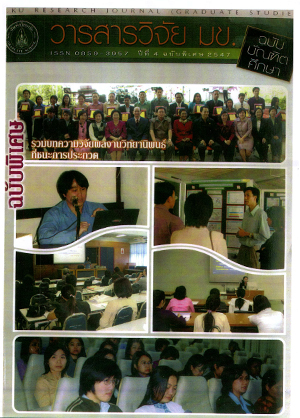ความถูกต้องของแผนที่นาข้าวที่ผลิตโดยใช้ข้อมูล LANDSAT-5 TM ซึ่งบันทึกในปีต่างกัน Accuracies of Paddy Field Maps Generated Using LANDSAT-5 TM Data Acquired in Different Years
Keywords:
remote sensing, paddy field maps, LANDSAT-5 TMAbstract
ในการจำนนกข้อมูลที่ได้จากการรับรู้ระยะไกลนาข้าวสามารถแยกออกจากสิงปกคลุมดินชนิดอื่นไต้เนื่องจาก ความแตกต่างของลักษณะการสะท้อน และการแผ่รังสี ซึ่งมีผลมาจากความชื้น ด้วยเหตุนี้การใข้ข้อมูลที่บันทึกในปี ที่มีปริมาณฝนต่างกันอาจให้ผลที่แตกต่างกัน การทึกษานี้ประกอบด้วยการวิเคราะห์ข้อมูล LANDSAT-5 TM ที่ บันทึกในช่วงคลื่นต่างๆในช่วงเปลี่ยนแปลงระหว่างฤดูฝนเป็นฤดูแลังของปีฝนมาก(2543) ฝนปานกลาง(2541) และฝนห้อย (2535) ด้วยวิธี Maximum Likelihood เพื่อทำแผนที่นาข้าว ผลการทึกษาแสดงว่าเทคนิคการ วิเคราะหํโดยใช้ข้อมูล TM 5 แบนด้ 3,4,5,6,7 ที่บันทึกในปีฝนปานกลางมีความเหมาะสมมากที่สุด กล่าวคือได้ แผนทซงมคาสมประสีทธ KAPPA = 82°/o, คา overall accuracy = 91 °/o, ค่า producer’s accuracy และ user’s accuracy ชองชื้นนาข้าว = 95°/o และ 94°/o ตามลำดับ นอกจากนั้นยังพบว่า จากการใช้วิธีเดียวกันนี้ไม'มีข้อมูลที่ บันทึกในปีใดสามารถใช้แยกนาข้าวชนิดต่าง ๆ ออกจากกันได้
In the digital classification of remotely sensed data, paddy fields can be distinguished from other land cover types because of the differences in their spectral characteristics due to the soil moisture contents. Therefore, the use of remotely sensed data acquired in different years having different amount of rainfall may yield different results. In this study, the use of LANDSAT-5 TM data acquired in the transition
between rainy and dry seasons of the years with high amount of rainfall (2000), intermediate amount of rainfall (1998) and low amount of rainfall (1992) were investigated for their appropriateness when used in paddy fields mapping. The results have shown that the use of 5 bands of TM data (bands 3,4,5, 6,7) acquired in the year with intermediate rainfall when classified using Maximum Likelihood method was the most appropriate. The map generated using this technique had the following statistics ะ KAPPA statistic = 82%, overall accuracy = 91% and producer’s accuracy and user’s accuracy of the paddy class were 95% and 94%, respectively. In addition, no technique investigated in this study could be used to distinguished different types of paddy fields.


